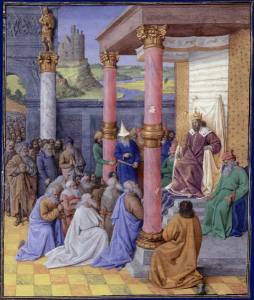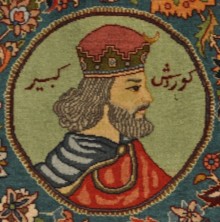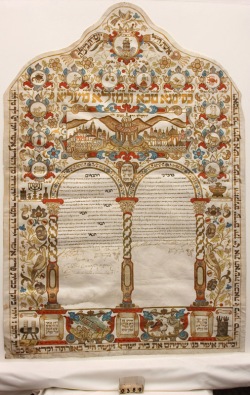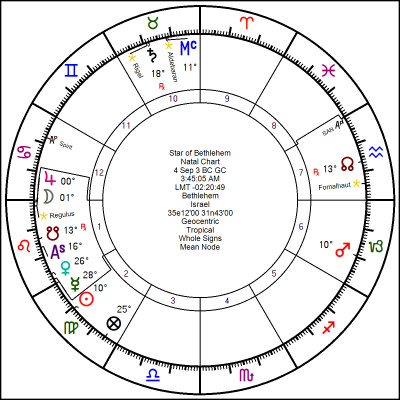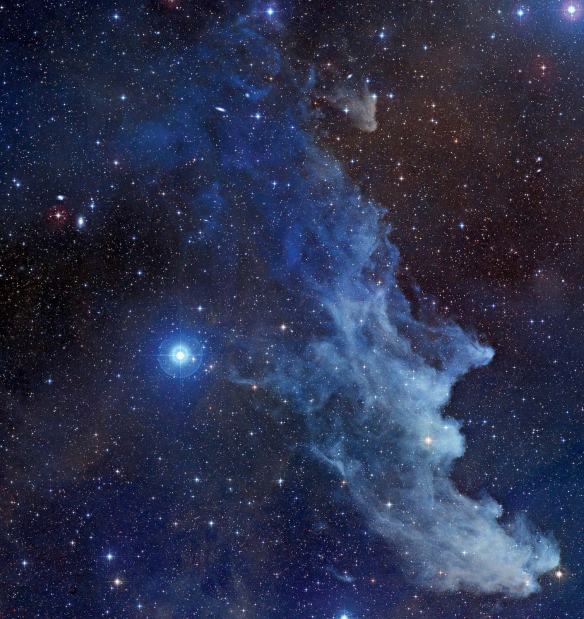Let me begin by stating clearly that I make no pretence to have finally solved the riddle of the Magi. I do hope that this short piece will contribute in a positive way to the ongoing study of the subject. In writing articles of this type, one needs to study the most recent scholarship as well as the ancient sources still extant. We may never know how much knowledge has been lost over the centuries, but we do know it was a great deal. These losses included the library of Alexandria and wholesale destruction of libraries during the Muslim invasions from North Africa, Persia and as far as India.
This continues from the two previous articles on the identity and nature of the Magi in particular relation to the Christmas story which combines Jewish and Persian elements. But first, it must be remembered that it is a story and it cannot be assumed that the narrator himself thought it to be an account of a temporal event. A story is not necessarily untrue, but it is a different kind of truth than the recalling of an historical event.
Further, our modern notion of historical accuracy is a fairly recent development. All cultures have maintained a mythological dimension to their own histories and it is often the case that the mythological tells us more about the society and its part in the greater cosmology than a historical “fact” might do. The latter is also subject to selective memory and various interpretations, while the former is more or less deliberately symbolic in nature. A popular and condescending euphemism for this second type of writing is “pious fiction.” The modern world needs to recover the meaning of an epiphany if it expects to understand ancient texts as they were intended to be read.
I intend to take a circuitous approach to explain what I have come to understand about the story of the Magi, involving solid astrology, interpreting mythological traditions as well as cultural realities.
Mark Kidger, an astronomer, writes that if the object was as bright as is reported in the Protovangelium of James, it would have to be at least as bright as the Moon and would have been recorded all over the world. He asks: was the star really brilliant? Did these early accounts use artistic license? Which of the accounts, if any, was the “correct” one? Where we even supposed to take the story of the Star literally? The Bible and the Apocryphal Gospels were never intended to be exact histories of the life of Jesus …. they are works written by the faithful for the faithful, and for those the writers hoped to convert.” (The Star of Bethlehem: An Astronomer’s View p. 19).
The interconnectedness and relative familiarity with different cultures in the Middle East, Rome, Greece, Egypt, and Persia are well documented but often trivialized. One cultural advantage of empires is the massive and facilitated flow of ideas, including familiarity with other languages. The Jews had been subjugated by the Romans, Babylonians, and Persians. Since the conquest of Alexander, they lived in a Hellenized world and it made for a heady mix. What emerged was a high degree of syncretism. One example was the existence of the Pharisees, a corruption of Parsi. The Jews appear to have adopted the idea of an afterlife in the Pharisee tradition, where the Sadducee school remained disinterested. The idea of an afterlife was shared by other cultures, but it would appear to be Zoroastrianism and the Persian influence that was primary
Certainly, the existence of the Magi was well known and their reputation was all but universally considered one of benevolence. Just as importantly, the Zoroastrian tradition had influenced the Greeks long before Plato, as well as Judaism. Jesus is considered by many scholars to be an Essene or at least influenced by them. The theme of the sons of darkness and sons of light has no other obvious equivalence than Zoroastrianism. We don’t find this theme in Greek or Jewish thought. Neither do we find it in Egyptian religion.
When we consider the details of the Christmas story, the role of the Magi is fascinating. First of all, the Jews were expecting a triumphant Messiah – a King of Kings from the House of David. The story of the virgin birth of a holy child, destined to redeem humanity and openly challenge the Judaism of the times is not what they had in mind. The humble birthplace of Jesus has become a symbol of humility to Christians, but it couldn’t have helped the Jews to accept him as the Messiah. Beyond Talmudic teachings, the case against Jesus being the Messiah derives from several key Scriptures: Isaiah 11:1-9, Isaiah 2:3-4, and Micah 4:2-3 among them.
The Christmas story might be seen as an attempted rebuttal to the disdain in the Jewish community. However, there is far more to it than that. The story may have been an attempt to illustrate a number of things, even if that meant excessive embellishment and resorting to “pious fiction.”
There have been countless attempts to identify the “star of wonder” ranging from a possible conjunction of Jupiter and Venus to a comet and a supernova. None of the theories so far has triumphed and we are left with the distinct possibility that the star being followed was of a spiritual nature – what we might call an inner light. No astronomer has been able to identify what it was – or if anything extraordinary was seen at all. My personal view is that the theories set forth haven’t taken the whole astrological picture into account.
The first “modern” attempt to discover what identifiable astronomical events could explain the star over Bethlehem really was conducted by Johannes Kepler identifiable astronomical phenomenon lies behind the biblical story of the so-called Star of Bethlehem was effectively begun by the astronomer Kepler (1571–1630),. Kepler was the mathematician to Rudolph II, Holy Roman Emperor
1576–1612. “In the years 1604–5 a supernova appeared in the constellation Ophiuchus and excited considerable discussion in Europe. Kepler kept a detailed record of his observations of the star. In the preceding year, 17 December 1603, at Prague he had also witnessed a conjunction of the planets Jupiter and Saturn with Mars moving into the vicinity soon after, which interested him in his capacity as court astrologer. The supernova appeared in the neighbourhood of these three planets. In

Jupiter-Saturn Conjunction Chart. Image credit: Star of the Magi
medieval times the conjunction of Jupiter and Saturn, known as the “great conjunction” (recurring only once every 19·86 [incorrect] years on average), was regarded as of great astrological significance. Kepler calculated that a similar conjunction with Mars moving into the vicinity soon after had occurred in the year 7 B.C. = Julian year 39. On that occasion, the conjunction had been a triple conjunction, a very much rarer event than the normal single conjunction.” (Sachs, A., & Walker, C. (1984). Kepler’s View of the Star of Bethlehem and The Babylonian Almanac for 7/6 B.C). At the end of the day, it turned out that Kepler had miscalculated and ever since then, one attempt after another to identify the star has failed.
William Eamon provides a summary of the process: “Kepler believed that the new star was a portent of deep significance. It was, he concluded, “an exceedingly wonderful work of God.” In 1606, he published a pamphlet, De Stella Nova in Pede Serpentarii (On the New Star in the Foot of Serpens), describing his discovery. Kepler was convinced that the new star was the same as the one that the Three Kings followed on their way to Bethlehem. With somewhat tortured logic, he reasoned that the new star was the equivalent of one that appeared in the same constellation around the time of the birth of Christ. He identified the supernova with a star that appeared in a conjunction of Jupiter and Saturn during the years 7-5 B.C. Since the supernova of 1604 appeared in the same conjunction, he reasoned, it had to be the same as the Star of Bethlehem that showed the Magi the way to Jesus.” (Kepler and the Star of Bethlehem)
It is crucial to remember that the Christmas story was written down long after the alleged events. Although not all scholars are in agreement, the majority believe that Mark was the first Gospel to be written, sometime around the year 70. This consensus has it that the Gospel of Matthew and the Gospel of Luke was written down sometime in the 9th or final decade of the 1st century. Obviously, this casts the authorship into doubt. It has been countered that the original four evangelists had completed gospels that were then transcribed by others at a much later date. However, the record doesn’t support this at all. Even the choice of which gospels would be included had a political and tendentious element in their selection.
Nevertheless, those who insist that everything written in the Bible is to be taken as literal truth will need to deny any metaphorical meaning at all. For the rest of us, we are free to consider the possibility that some passages or stories in the Bible are powerfully metaphorical and that metaphor and elaboration can add to the power of the truth being told, even if it had no actual historical existence. It does not seem out of place here to mention that the modern understanding of history conforms to linear time. The very idea of linear time is an extreme abstraction with no modern scientific basis. It is part of the materialist creed.
Zoroastrianism, like Christianity, is a Universal religion. As mentioned, the Jews also had every reason to venerate the Magi, emissaries from the East: The following is what is known as the Proclamation of Cyrus from Ezra 1:1-8 (ESV):
1 In the first year of Cyrus king of Persia, that the word of the Lord by the mouth of Jeremiah might be fulfilled, the Lord stirred up the spirit of Cyrus king of Persia, so that he made a proclamation throughout all his kingdom and also put it in writing:
2 “Thus says Cyrus king of Persia: The Lord, the God of heaven, has given me all the kingdoms of the earth, and he has charged me to build him a house at Jerusalem, which is in Judah. 3 Whoever is among you of all his people, may his God be with him, and let him go up to Jerusalem, which is in Judah, and rebuild the house of the Lord, the God of Israel—he is the God who is in Jerusalem. 4 And let each survivor, in whatever place he sojourns, be assisted by the men of his place with silver and gold, with goods and with beasts, besides freewill offerings for the house of God that is in Jerusalem.”
5 Then rose up the heads of the fathers’ houses of Judah and Benjamin, and the priests and the Levites, everyone whose spirit God had stirred to go up to rebuild the house of the Lord that is in Jerusalem. 6 And all who were about them aided them with vessels of silver, with gold, with goods, with beasts, and with costly wares, besides all that was freely offered. 7 Cyrus the king also brought out the vessels of the house of the Lord that Nebuchadnezzar had carried away from Jerusalem and placed in the house of his gods. 8 Cyrus king of Persia brought these out in the charge of Mithredath the treasurer, who counted them out to Sheshbazzar the prince of Judah.
Among the classical Jewish sources, besides the Bible, Josephus (1st century AD) mentions that Cyrus freed the Jews from captivity and helped rebuild the temple. He also wrote to the rulers and governors that they should contribute to the rebuilding of the temple and assisted them in rebuilding the temple. A letter from Cyrus to the Jews is described by Josephus.:
KING CYRUS TO SISINNES AND SATHRABUZANES SENDETH GREETING.
“I have given leave to as many of the Jews that dwell in my country as please to return to their own country, and to rebuild their city, and to build the temple of God at Jerusalem on the same place where it was before. I have also sent my treasurer Mithridates, and Zorobabel, the governor of the Jews, that they may lay the foundations of the temple, and may build it sixty cubits high, and of the same latitude, making three edifices of polished stones, and one of the wood of the country, and the same order extends to the altar whereon they offer sacrifices to God. I require also that the expenses for these things may be given out of my revenues. Moreover, I have also sent the vessels which king Nebuchadnezzar pillaged out of the temple, and have given them to Mithridates the treasurer, and to Zorobabel the governor of the Jews, that they may have them carried to Jerusalem, and may restore them to the temple of God. Now their number is as follows: Fifty chargers of gold, and five hundred of silver; forty Thericlean cups of gold, and five hundred of silver; fifty basons of gold, and five hundred of silver; thirty vessels for pouring [the drink-offerings], and three hundred of silver; thirty vials of gold, and two thousand four hundred of silver; with a thousand other large vessels. [Note] I permit them to have the same honour which they were used to have from their forefathers, as also for their small cattle, and for wine and oil, two hundred and five thousand and five hundred drachma; and for wheat flour, twenty thousand and five hundred artabae; and I give order that these expenses shall be given them out of the tributes due from Samaria. The priests shall also offer these sacrifices according to the laws of Moses in Jerusalem; and when they offer them, they shall pray to God for the preservation of the king and of his family, that the kingdom of Persia may continue. But my will is, that those who disobey these injunctions, and make them void, shall be hung upon a cross, and their substance brought into the king’s treasury.”
And such was the import of this epistle. Now the number of those that came out of captivity to Jerusalem were forty-two thousand four hundred and sixty-two.”
The somewhat terse account in Matthew is expanded upon, with both similarities and differences in the apocryphal Protoevengelium of James. This work is overwhelmingly concerned with Mary, Joseph, establishing the legitimacy of the Christ child and answering all the kinds of questions that might be asked about a virgin birth and the birth of the Christ child. James also gives us this:
“21. And, behold, Joseph was ready to go into Judæa. And there was a great commotion in Bethlehem of Judæa, for Magi came, saying: Where is he that is born king of the Jews? For we have seen his star in the east, and have come to worship him. And when Herod heard, he was much disturbed and sent officers to the Magi. And he sent for the priests, and examined them, saying: How is it written about the Christ? Where is He to be born? And they said: In Bethlehem of Judæa, for so it is written. And he sent them away. And he examined the Magi, saying to them: What sign have you seen in reference to the king that has been born? And the Magi said: We have seen a star of great size shining among these stars, and obscuring their light so that the stars did not appear; and we thus knew that a king has been born to Israel, and we have come to worship him. And Herod said: Go and seek him; and if you find him, let me know, in order that I also may go and worship him. And the Magi went out. And, behold, the star which they had seen in the East went before them until they came to the cave, and it stood over the top of the cave. And the Magi saw the infant with His mother Mary, and they brought forth from their bag gold, and frankincense, and myrrh. And having been warned by the angel not to go into Judæa, they went into their own country by another road. .”
If we come to these passages expecting to learn of a physical celestial event, that is what we will understand. However, this is not the only possible interpretation of ” a star of great size shining among these stars, and obscuring their light, so that the stars did not appear; and we thus knew that a king has been born to Israel, and we have come to worship him.” Could this not be written in the same spirit as “The light shineth in the darkness” in the Gospel of John? As I mentioned, the greatest irony of a belief in literalism is that it ignores that the very act of writing or story-telling is
metaphorical. They are part of how we process what we see. Even a technical manual will, more often than not, contain language that is not entirely literal. Turning to Judeo-Christian scripture we recognize that a direct command to “love your neighbour: can be taken at face value, even if understanding precisely what that means is subject to interpretation. The story of Jonah and the whale is a good case in point. We know that what happens in the story is impossible to explain using scientific principles. People cannot live inside whales, but if we out our material doubts aside, the story is rich in metaphorical meaning. Not believing that humans can live in whales is not cause for accusations of blasphemy except by the most extreme and demented American Evangelical Fundamentalist.
Many stories in the Bible are replete with metaphorical thought and in many cases re-telling of stories from other cultures, such as Egypt and Babylon. They are not primarily historical documents, although that are many who treat them as if they were.The first task of scripture is to impart spiritual truths and present material that illustrates the way of righteousness and the consequences of ignoring the wise. In that sense, Hindu scripture is of the same kind. There may very well be historical references, but history itself is not the most important factor.
There are many elements here that are immediately germane to the art of astrology. The more mystical the content, the more literalism falls away. What is above, is below. We are born of stars and the light we experience is microcosmic as well as macrocosmic. We speak of illuminated minds and an inner light. We also speak of the benighted consciousness and the “outer darkness.” In the Gospels, the “exterior darkness” or “outer darkness” is a place referred to three times in the Gospel of Matthew (8:12, 22:13, and 25:30) into which a person may be “cast out”, and where there is “weeping and gnashing of teeth”.
“The Sages and the Star-Child: An Introduction to the Revelation of the Magi, An Ancient Christian Apocryphon” is the title of a PhD dissertation by Brent Christopher Landau of The Faculty of Harvard Divinity School.
Landau “analyzes a poorly-known ancient Christian apocryphal writing, termed the Revelation of the Magi. This document purports to be the personal testimony of the biblical Magi on the coming of Christ, and is the longest and most complex narrative devoted to the Magi surviving from antiquity.” The thesis is compelling and at the very least provides a fairly detailed first-hand account of the experience from the Magi point of view.
The entire dissertation is available online, so I see no useful purpose in rehearsing it here, but there are several things that need to be said. The purpose and general focus of this series of articles on the Magi are on magic, metaphor, and astrology. Here we have an astronomical event that probably didn’t occur at all, read by Magi who were astrologers. The realization that the star was Christ himself, in perhaps a similar sense as we see in his transfiguration. All three Synoptic Gospels tell the story of the Transfiguration (Matthew 17:1-8; Mark 9:2-9; Luke9:28-36). With a remarkable agreement, all three place the event shortly after Peter’s confession of faith that Jesus is the Messiah and Jesus’ first prediction of his passion and death.
Perhaps the greatest anathema to astrology according to Christian theologians is the mistaken view that astrologers believe the stars dictate what will happen to individuals and societies. In their view, this somehow circumvents the will of a supreme being, when in fact the astrologer reads the signs to gain knowledge of divine will. Sorcerers and fortune tellers are considered to be cut from the same cloth as astrologers. However, in Judaism and Zoroastrianism, the stars are clearly understood to be useful and several books in the Jewish Bible, such as The Book of Daniel are saturated with astrological meaning. Yet in the Tanakh, we find The metaphor of the clock and time is germane here. The clock doesn’t create time, it just tells you what time it is.
It’s increasingly apparent that the importance of astrology in Judaism increased during the Babylonian captivity and the strong and friendly contacts with the Persians, who maintained a fairly practical form of the art.
It should be noted that there very few Jews would deny the presence of astrology in the Tanakh, but there would be reservations s well. – However, “two biblical passages dealing with the diviner (menaḥesh) and soothsayer (me’onen; Lev. 19:26; Deut. 18:10) were understood by the rabbis as bearing relation to astrology (Sanh. 65b–66a; cf. Maim. Yad, Avodah Zarah 11:8, 9). The prophets were aware of the practices of “star-gazers” (ḥoverei ha-shamayim) among the Babylonians and other peoples but they scoffed at them (Isa. 47:13; Jer. 10:2). In the book of Daniel the Babylonian astrologers arecalled kasdim (Chaldeans), and in Aramaic kasda’ei (2:2, 4, 5, 10; 4:14; 5:7, 11). The Sibylline Oracles (219–231) praise the Jewish people for refraining from astrology, which is a delusion. The Book of Jubilees (12:16–18) depicts the patriarch Abraham as overcoming the beliefs of the astrologers. The first Book of Enoch (8:3) includes astrology among the sins spread among mortals by the primeval giants (nefilim). Josephus, however, writes that astrology was common among the Jews in his days and that Jewish misinterpretation of celestial signs was partially responsible for the outbreak of the revolt against the Romans and its continuation for four years (Jos., Wars, 6:288ff.)”Source: Encyclopaedia Judaica. © 2008 .
1300 years later, Moses Maimonides was vehemently opposed to the practise of astrology, but his view had virtually no influence on subsequent Jewish writers. Astrology had become an integral element of Judaism. After all, the Yiddish mazel tov derives from Hebrew words meaning a constellation of good stars and destiny. Considering the extraordinary influence and reputation of Maimonides, this stands as a strong endorsement of astrology by the Jewish community.
“With the exception of Joseph Judah ibn Aknin and his enthusiastic admirer R. *Jedaiah ha-Penini (Bedersi), none of the Jewish philosophers of the succeeding generations opposed or deprecated astrology. Even the rationalistic *Levi b. Gershom maintained that the activities and events of a man’s life were predestined by the positions and movements of celestial bodies. The astrologers fail, he asserted, first of all because of insufficient knowledge about the movements of the stars and the effects of their changed positions on sublunar beings, and secondly, because of the intervention of intellect and free will, “for the intellect and the will are empowered to carry us beyond the limitations imposed by the celestial bodies” (Milḥamot Adonai 2:2). Shem-Tov ibn *Falaquera also considered astrology a true science and made use of it. Many of the great rabbis, commentators, preachers, and ethical teachers dealt with astrology and were favourably disposed toward it; *Abraham b. David of Posquières, in his Hassagot, a commentary on Maimonides’ Mishneh Torah; *Naḥmanides (Commentary on Gen. 1:16; Lev. 23:24, and passim) and his pupil Solomon b. Abraham *Adret (Responsa, no. 652); *Baḥya b. Asher (Commentary on Ex. 11:4; and passim); Isaac *Aboab (Menorat ha-Ma’or, 143; passim); Simeon b. Ẓemaḥ *Duran (Magen Avot, 72bff., and Tashbeẓ, no. 513); Isaac *Abrabanel , who cited many proofs “from the science of astronomy in regard to the celestial conjunctions” for his opinion that the redemption of Israel would begin in 1503 and come to completion in 1531 (Ma’yenei ha-Yeshu’ah, 12:2); Isaac *Arama (Akedat Yiẓḥak, 34, 56), though he disapproved of eschatological reckonings based on astrology; Moses b. Ḥayyim *Alshekh ; *Judah Loew b. Bezalel (Maharal) of Prague, who is reputed to have practiced astrology in the company of his friend Tycho Brahe; David *Gans ; Leone of *Modena ; Joseph Solomon *Delmedigo of Candia, Jonathan *Eybeschuetz ; and *Elijah , Gaon of Vilna (Commentary on Sefer Yeẓirah). A definitely negative attitude toward astrology was assumed by Azariah dei *Rossi” (Me’or Einayim, 42, 43). Source: Enyclopaedia Judaica. © 2008c
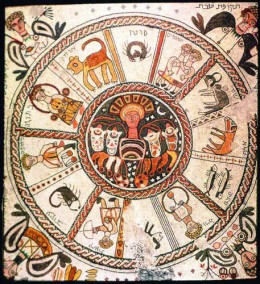
Detail of the ancient kibbutz Beth Alpha mosaic, Israel: a zodiac wheel with all 12 symbols and names of the zodiac, surrounded by four female figures at the corners, identifying the seasons of the year; at the centre, Helios, the sun god driving a quadriga, with moon and stars. (Picture: Art Resource, NY; biblicalarchaeology.org/via @Inés Peschiera Kežman Pfeifer)
Most importantly, traditional astrology views the stars as microcosm and the macrocosm. In most cases, we study the macrocosmic heavens to shed light on the microcosm. In the case of the Star Child, we have the Magi reading the advent of Christ by an inner illumination. This appears to be the message when we have looked at all the sources and considered the identity of the players in this cosmic drama. We talk about “outer space” but there is a corresponding “inner space.”
Of course, the proclamation that the Kingdon of Heaven is within you is used only by Matthew. Mark and Luke used “kingdom of God” Compare Matthew 11:11-12 with Luke 7:28; Matthew 13:11with Mark 4:11 and Luke 8:10; Matthew 13:24 with Mark 4:26; Matthew 13:31 with Mark 4:30 and Luke 13:18; Matthew 13:33 with Luke 13:20; Matthew 18:3 with Mark 10:14 and Luke 18:16; and Matthew 22:2 with Luke 13:29. The two phrases clearly mean the same thing.
If we revisit words of the Magi in Matthew: “Now after Jesus was born in Bethlehem of Judea in the days of Herod the king, behold, wise men from the East came to Jerusalem, saying, Where is He who has been born King of the Jews? For we have seen His star in the East [or at its rising and have come to worship Him ” we are left with a tantalizing and evocative image, but we still don’t have any idea what this rising star was. It was common to refer to planets as stars, but there isn’t anything close to bright enough to match the description.
If we take this account at face value and ignore the impossible exaggerations which have, ironically, obscured all the main points, we would have a chart very similar to this.
This chart shows the rising of Jupiter the king planet, in the royal sign of Leo and with the Kings’ star, Regulus. This certainly fits with the description of the Star in the East. It is ascending ahead of the Sun with enough clearance from the Sun to allow visibility.
Regulus, in Leo (The Lion), means “little king,” named by Copernicus. It is the heart of the Lion and associated with generosity and ambition. If well aspected it will raise the person to high positions in life and denotes successful activity. Its nature is Mars and Jupiter. Bayer name Alpha Leo. Apparent magnitude +1.3 This star rising with Jupiter would have been considered a strong indicator of the birth of a king when combined with the other elements present.
Some have suggested that “born of a Virgin” means the Sun in Virgo. I see no compelling reason to take this view, but it may be worthy of further research. We can say that the Sun in Virgo is suggestively positioned.
The triple conjunction of Venus and Mercury and the Ascendant with Jupiter would make for a convincing candidate for the birth of a great king in Babylonian as well as Persian astrology. The Moon is in her domicile in Cancer and Mars in his Exaltation is safely in the 6th house, like a tiger in a cage. This is where Mars has his Joy.
Saturn retrograde and conjunct the Midheaven is more sinister. The Jews are under the governance of Saturn and this new king is not welcome by the highest authorities. There is a tight conjunction of Saturn with the fixed star Rigel, the brightest star in Orion, The Hunter (Apparent magnitude +0.3) The star is of the nature of Jupiter and Saturn and associated with fame, wealth, and lasting honours. Rigel is a fortunate star and a very powerful one. This would serve as a protective element.
This is the most likely way that the Magi determined the location of the birth. Saturn conjunct the MC is in the place of authority. It is only natural that they would visit Herod.
I make no claims to this being the exact date, but the time would be close enough to provide us with an accurate enough and relatively short window for this configuration to occur, making this a strong candidate for something approaching what must have occurred.
It seems ironic that many of the attempts to embellish and exaggerate the message of the Magi have obscured what might otherwise have been obvious.
The Magi are what scripture and tradition say they are – highly skilled astrologers, almost certainly from Persia. There has been a number of attempts over the years to make them appear to be like a Unicef greeting card depicting them as all Jewish kings from Yemen.
I don’t believe that The Star-Child account is meant to be taken entirely literally, but it is a rather lovely narrative of the Star leading to the Child. For approximately two billion Christians, Christ is their Guiding Star


